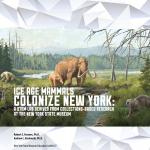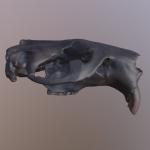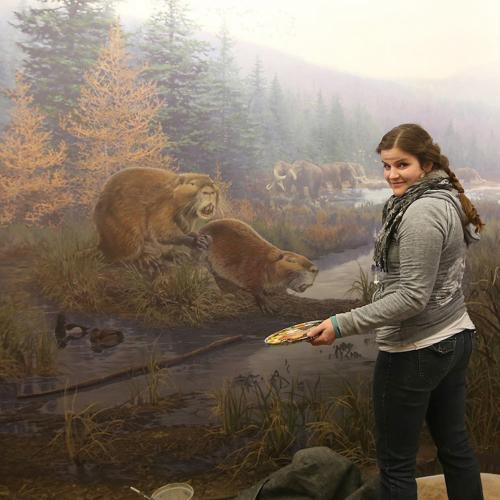Travel back 20,000 years to New York State’s last great Ice Age when mammoths, reindeer, sloths, and even whales once resided here. Join Pleistocene Paleontologist, Robert Feranec, on a tour of the Ice Ages exhibit and discover how ice shaped land and life during this “cool” period in New York’s geologic history.
Ice Age Resources
Included here are several different resources available from the New York State Museum related to the last glacial Ice Age. Take a virtual tour of the exhibit, download educational materials, gain access to additional 3D scans of materials from the NYSM Collection, and link to related scientific publications by NYSM staff.
Explore the Ice Ages Exhibit
Website: The Cohoes Mastodon
For the past 150 years, the Cohoes Mastodon has been a beloved feature of the New York State Museum. Learn more about its life and origins, its ancient and modern past, and how the Cohoes Mastodon will continue to intrigue and thrill Museum-goers for years to come.
Education Leaflet: Ice Age Mammals Colonize New York: A Stem Lab Derived from Collections-Based Research at the NYSM (PDF)
The purpose of this leaflet is to provide information to primary and secondary school educators and students relating to collectionsbased research at the New York State Museum addressing the question: “After the last Ice Age, when did species first colonize New York?”
3D Scans of Ice Age Objects from the NYSM
Dr. Bernard Means, a professor at Virginia Commonwealth University, came to the NYSM to take 3D scans of specimens in the vertebrate paleontology and archaeology collections, including the Cohoes Mastodon and a mammoth skull. The scans provide a high quality, three-dimensional digital archive of the specimens. In some cases, the 3D scans can be utilized instead of the actual specimen for research and exhibition.
About the Ice Age Murals
For this exhibit, two giant murals were commissioned to represent the habitats and animals present during the last Ice Age in the region of New York State. The tundra mural, measuring 19” x 8', and the boreal forest mural, measuring an extensive 39” x 8", were both created by the artist Beth Zaiken.
Before graduating from the Rhode Island School of Design, Beth painted large-scale murals in civic buildings in Rochester, Minnesota. In college, she sharpened her skills in traditional and digital media, and found another passion in reconstructing extinct animals and landscapes, and ancient civilizations and architecture. She particularly enjoys the challenge of depicting extinct or scarce creatures. Deeply concerned about conservation issues, Beth uses her gifts to draw attention to amazing creatures and emphasize the need for urgent conservation efforts. Beth works in traditional and digital media and specializes in large-scale landscape murals and reconstructions of prehistoric animals.
Currently, Beth is a principal artist and muralist for Blue Rhino Studio, a well-known museum design and fabrication firm in Minneapolis. A native of the Minnesota prairie, Beth loves her quiet life with her husband, Mark, and their two dogs, Nessie and Booker. Here she can concentrate on her work, and the daily views of wide-open skies and sparkling lakes and rivers are an indispensable part of their lives.
For more information about Beth Zaiken and her work, visit: www.bethzaiken.com
Related Publications & Recent Research on NYSM Ice Age Specimens and Glacial Geology:
Presslee, S., Slater, G.J., Pujos, F., Forasiepi, A.M., Fischer, R., Molloy, K., Mackie, M., Olsen, J.V., Kramarz, A., Taglioretti, M., Scaglia, F., Lezcano, M., Lanata, J.Luis, Southon, J., Feranec, R.S., Bloch, J., Hajduk, A., Martin, F.M., Gismondi, R.Salas, Reguero, M., de Muizon, C., Greenwood, A., Chait, B.T., Penkman, K., Collins, M., MacPhee, R.D.E., 2019. Palaeoproteomics resolves sloth relationships. Nature Ecology & Evolution 3, 1121–1130. doi:10.1038/s41559-019-0909-
McDonald, H.G., Feranec, R.S., Miller, N., 2019. First record of the extinct ground sloth, Megalonyx jeffersonii, (Xenarthra, Megalonychidae) from New York and contributions to its paleoecology. Quaternary International 530-531, 42-46. doi:10.1016/j.quaint.2018.11.021
Feranec, R.S., Kozlowski, A.L., 2018. Onset Age of Deglaciation Following the Last Glacial Maximum in New York State Based on Radiocarbon Ages of Mammalian Megafauna, in: Kehew, A.E., Curry, B.B. (Eds.), Quaternary Glaciation Of The Great Lakes Region: Process, Landforms, Sediments, And Chronology. Geological Society of America, Boulder, Colorado. doi:10.1130/2017.2530(09)
Feranec, R.S., Kozlowski, A.L., 2016. Implications of a Bayesian radiocarbon calibration of colonization ages for mammalian megafauna in glaciated New York State after the Last Glacial Maximum. Quaternary Research 85, 262-270. doi:10.1016/j.yqres.2016.01.003
Cleland, T.P., Schroeter, E.R., Feranec, R.S., Vashishth, D., 2016. Peptide Sequences from the First Castoroides ohioensis Skull and the Utility of Old Museum Collections for Palaeoproteomics. Proceedings of the Royal Society B: Biological Sciences 283, 20160593. doi:10.1098/rspb.2016.0593
Feranec, R.S., Franzi, D.A., Kozlowski, A.L., 2014. A New Record of Ringed Seal (Pusa hispida) from the Late Pleistocene Champlain Sea and Comments on Its Age and Paleoenvironment. Journal of Vertebrate Paleontology 34, 230-235. doi:10.1080/02724634.2013.784706
Kozlowski, A.L., Bird, B., Lowell, T.V., Smith, C.A., Feranec, R.S., Graham, B.L., 2018. Minimum Age of the Mapleton, Tully, and Labrador Hollow Moraines Indicates Correlation with the Port Huron Phase in Central New York State, in: Quaternary Glaciation Of The Great Lakes Region: Process, Landforms, Sediments, And Chronology. Geological Society of America, Boulder, Colorado, pp. 191–216. doi:10.1130/2018.2530(10)







